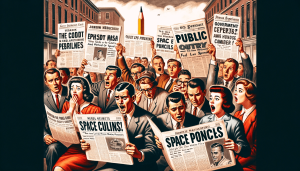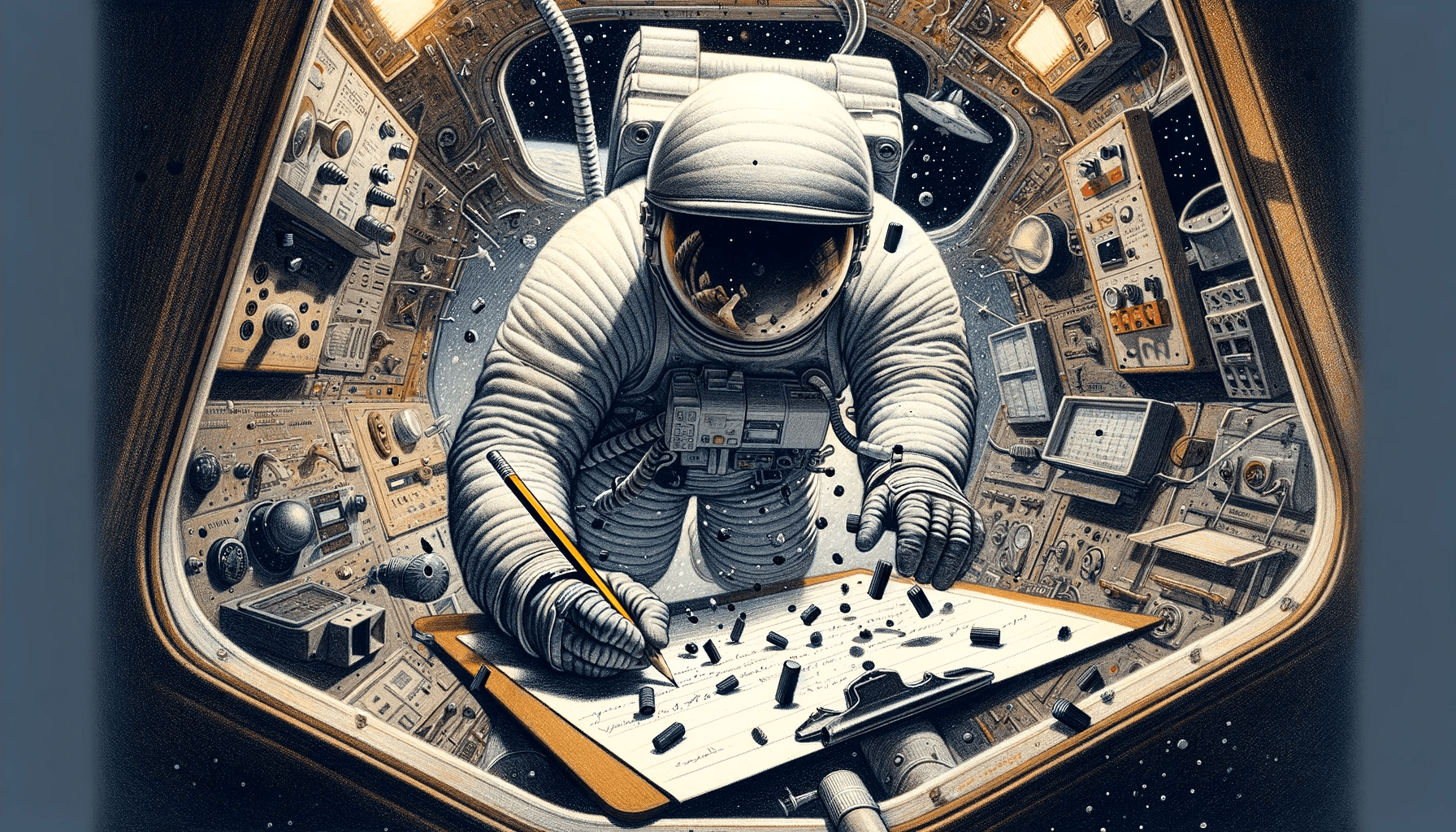In the vast expanse of space, even the simplest tasks can become complex challenges. “Why did NASA spend millions developing a pen that would work in space when a pencil is just as good?”
This question taps into a broader narrative of innovation versus practicality. As we embark on this exploration, we’ll unravel the intricate layers behind NASA’s decision, addressing the practical pain points of writing in zero gravity and the quest for safer, more reliable tools.
Prepare for unique insights into the space pen’s journey, a tale of ingenuity that transcends the cosmos.
The Pencil Controversy Preceding the Space Pen
The Early Space Missions and Pencil Use
In the nascent days of space exploration, NASA astronauts reached for the familiar comfort of pencils to jot down their celestial observations.
Yet, these ordinary instruments were not without their faults. Graphite dust, a seemingly innocuous by-product of pencil use on Earth, posed a significant risk in the microgravity of space, where it could freely float, potentially infiltrating delicate equipment or even the lungs of astronauts.
Moreover, the flammability of pencils presented a stark hazard in the oxygen-rich environment aboard spacecraft. These concerns necessitated a solution that maintained the functionality of a writing instrument without compromising the safety of the astronauts and their mission.
Public Outcry Over Space Pencil Costs
The plot thickened when the public learned of the exorbitant costs associated with the mechanical pencils supplied to astronauts. A whopping $128.89 per pencil was enough to cause a national stir and bring NASA’s budgetary decisions under the microscope.
This scrutiny was not just about the pencils themselves but a symbol of a larger conversation about government spending and the stewardship of taxpayer dollars.
The public demanded accountability and frugality, igniting a quest for a cost-effective alternative that would not sacrifice performance in the unforgiving theatre of space.
Transitioning from Pencils to Pens
The transition from pencils to pens was not merely a change in writing instruments but a leap towards technological innovation and astronaut safety.
The development of the space pen was a testament to human ingenuity, a solution born from the convergence of necessity and possibility.
This shift marked a significant milestone in space exploration technology, as it underscored the relentless pursuit of improvement and adaptation in the face of unique challenges posed by the space environment.
Paul C. Fisher’s Innovation
The Invention Process of the Space Pen
Paul C. Fisher’s journey to creating the space pen was not just a stroke of genius but a meticulous process of innovation and problem-solving. With his background in pen manufacturing and design,
Fisher set out to create a writing instrument that could defy the challenges of space. The space pen, known for its reliability in zero gravity, extreme temperatures, and even underwater, was born from this relentless pursuit.
Fisher’s invention process was driven by the need for a safe and dependable tool for astronauts, leading to the development of the thixotropic ink—a key component that would allow writing in conditions where ordinary pens would fail.
Investment and Development Without NASA Funds
Contrary to popular belief, the development of the space pen did not dip into NASA’s pockets. It was Paul C. Fisher’s personal investment and the risk taken by the Fisher Pen Company that brought this revolutionary tool to life.
The myth of NASA funding the space pen has been debunked, with records showing that Fisher invested around $1 million of his own money into the development of the thixotropic ink and the pen’s unique design.
This section will delve into the financial and technical challenges Fisher overcame, highlighting the entrepreneurial spirit that fuelled this space-age innovation.
Achieving a Pen That Writes Anywhere
The space pen’s claim to fame is its ability to write in the most extreme conditions imaginable. From the vacuum of space to the depths of the ocean, the pen’s technical breakthroughs have made it a versatile tool for astronauts and adventurers alike.
The pen’s design, featuring a pressurized ink cartridge and a precision-fitted tungsten carbide ballpoint, allows it to operate in a wide range of temperatures and at any angle—capabilities that ordinary pens simply cannot match.
This section will explore how these innovations not only solved the practical problems of writing in space but also captured the imagination of people around the world.
NASA’s Adoption of the Space Pen
Rigorous Testing for Space Suitability
NASA’s adoption of the space pen was not a decision taken lightly. Before the pen could accompany astronauts on their missions, it had to undergo rigorous testing to ensure its suitability for the harsh conditions of space.
NASA’s engineers tested the pen’s performance in simulations of extreme temperatures, pressures, and environments that replicated the challenges of space travel.
This section will delve into the specifics of these tests, highlighting the pen’s reliability and the confidence it instilled in the astronauts who would rely on it for their important documentation work in space.
The focus on equipment testing and reliability was paramount, as the pen had to meet the stringent standards set by NASA for all space mission gear.
Official Use in Apollo Missions
The space pen’s journey to the stars was solidified with its official use in the Apollo missions, marking a significant milestone in space technology.
The pen’s debut was during the Apollo 7 mission in 1968, where it was used in a live television broadcast, demonstrating its functionality in weightlessness.
This historic use of the space pen not only showcased American ingenuity but also represented a leap in technological advancements that supported the moon landing and subsequent space exploration efforts.
The pen, now a symbol of this era, continues to be celebrated in pop culture and remains an emblem of the innovative spirit that propelled the space race.
The Space Pen’s Role in Spacecraft Safety
The space pen’s design was not just about functionality; it was also about safety. In the confines of a spacecraft, every item must be accounted for, and every risk mitigated.
The space pen offered a safe alternative to pencils, whose graphite could break and pose a hazard to astronauts and sensitive electronics.
Its reliability and safety features made it an essential tool for astronauts, ensuring that the act of writing, a simple yet crucial task, would not compromise the safety of the mission or the crew.
This section will discuss how the space pen’s design addressed potential space hazards and contributed to the overall safety design of space missions, reinforcing the importance of meticulous attention to detail in all aspects of space travel.

The Soviet Union’s Transition to the Space Pen
Soviet Space Program’s Initial Writing Tools
The Soviet space program, much like its American counterpart, faced the challenge of finding reliable writing instruments for use in space. Initially, Soviet cosmonauts turned to grease pencils as their tool of choice.
However, these pencils came with their own set of issues, such as the difficulty of handling and storing the grease marks they left behind. This section will explore the reasons behind the Soviet Union’s quest for better writing alternatives, delving into the space race era’s demands for equipment that could withstand the rigors of space travel.
Adoption of the Fisher Space Pen
The decision by the Soviet Union to adopt the Fisher Space Pen for their Soyuz missions was a pivotal moment in space exploration history.
This section will explore the thought process and the decision-making that led to this adoption, emphasizing the pen’s superior functionality over traditional writing tools.
The Fisher Space Pen was not just a tool but a symbol of technological progress, one that the Soviets recognized as beneficial for their space endeavours.
The pen’s ability to write in zero gravity and other extreme conditions made it an invaluable asset for the cosmonauts aboard the Soyuz spacecraft.
Cross-National Use and Space Collaboration
The use of the Fisher Space Pen by both American astronauts and Soviet cosmonauts stands as a testament to the pen’s universal appeal and functionality.
This section will highlight the significance of this cross-national use, which, in the midst of the space race, served as a rare symbol of international cooperation and space collaboration.
The shared use of the space pen not only facilitated the practical aspects of space missions but also represented a form of unity, transcending geopolitical boundaries and fostering a spirit of shared human endeavour in the exploration of space.
The Space Pen’s Design and Functionality
Engineering Behind the Pressurized Ink Cartridge
The space pen, a marvel of engineering, is renowned for its pressurized ink cartridge, which is the cornerstone of its functionality. This ingenious design allows the pen to write in the vacuum of space, underwater, and on greasy surfaces.
The cartridge is pressurized with nitrogen, which means that unlike ordinary pens that rely on gravity to work, the space pen can write in zero gravity and at any angle. This feature was critical for astronauts who needed to write in space, where traditional pens would simply not work.
The Pen That Writes in Extreme Temperatures
Another remarkable feature of the space pen is its ability to function in extreme temperatures, ranging from -34 to 121 degrees Celsius. This temperature resilience was essential for space missions, where temperatures can vary drastically.
Whether it’s the cold vacuum of space or the intense heat of a spacecraft re-entering the Earth’s atmosphere, the space pen can handle it all, ensuring that astronauts can write down crucial information at any moment.
Versatility in Writing Surfaces and Positions
Versatility is a key component of the space pen’s design. It can write on almost any surface, including wet, greasy, and even rough textures. This versatility extends to its ability to write in any position, which is vital in the zero-gravity environment of space.
Astronauts could write while floating in their spacecraft without worrying about the orientation of the pen, making it an indispensable tool for space missions.
The space pen’s design and functionality are a testament to human ingenuity and the relentless pursuit of innovation. Its creation not only solved practical problems for astronauts but also became a symbol of the technological advances that space exploration has spurred.
The pen’s ability to write in extreme conditions and its adoption by space programs around the world highlight its significance as a tool that transcends boundaries, both literally and metaphorically.

Marketing the Space Pen
Crafting the Narrative: The Pen That Went to the Moon
The Fisher Space Pen Co. didn’t just sell a writing instrument; they sold a story. By branding their product as “the pen that went to the Moon,” they tapped into the public’s awe of the Apollo missions and the universal human fascination with space exploration.
This narrative was more than just a marketing strategy; it was a powerful message that connected consumers with the grandeur of space travel. The impact on sales was astronomical, as people were eager to own a piece of history that symbolized human achievement.
Commercial Success and Public Fascination
The space pen’s journey from a functional tool for astronauts to a coveted item for the public showcases its commercial triumph.
The pen’s association with space missions sparked a public fascination, turning it into a collector’s item and a tangible connection to the space age.
This fascination drove sales, as owning a space pen meant possessing a fragment of space history, a narrative that resonated deeply with consumers and enthusiasts of space memorabilia.
Branding and Positioning in the Market
Fisher’s branding strategies were a masterclass in market positioning. They transformed the space pen from a specialized tool into an iconic product that appealed to a broad audience.
By leveraging its unique story and functional superiority, the space pen was positioned not just for those interested in aerospace but for anyone who valued innovation and reliability. This strategic positioning carved out a unique identity for the space pen in the market, making it synonymous with quality and adventure.
The marketing of the space pen is a prime example of how a product can transcend its utilitarian purpose to become a symbol of an era.
Through clever narrative crafting, strategic branding, and tapping into the public’s imagination, the space pen became more than just a writing instrument; it became a piece of cultural heritage, a memento of human progress, and a testament to the power of storytelling in marketing.

Legacy and Continued Use
The space pen, a remarkable example of human ingenuity, continues to be an essential tool in modern space missions. Its design and functionality have stood the test of time, proving to be as relevant today as it was during the Apollo missions.
The pen’s ability to write in zero gravity, over grease, and in extreme temperatures makes it indispensable for astronauts who require reliable tools in the challenging conditions of space.
The Space Pen in Modern Space Missions
The space pen has not only a storied legacy but also a vibrant present and future in space exploration. It has been used on every crewed NASA mission since Apollo 7 and remains aboard the International Space Station (ISS) today.
This pen’s continued use underscores its reliability and the ongoing need for practical writing instruments in space. The technology behind the space pen was recognized for its innovation on Earth in 2021, further cementing its place in both space history and current missions.
The Space Pen’s Contribution to Space Safety
Safety is paramount in space missions, and the space pen contributes significantly to this aspect.
Its design prevents the issues associated with broken pencil leads, which can float freely in a spacecraft, posing risks to both astronauts and sensitive equipment.
The pen’s reliability and safety features make it a preferred choice over other writing instruments, ensuring that astronauts can perform their tasks without worrying about potential hazards.
The Space Pen as a Symbol of Innovation
The space pen stands as a testament to human creativity and the relentless pursuit of solutions to complex problems. It symbolizes the innovative spirit required for space exploration and serves as a reminder of what can be achieved when ingenuity is applied to overcome the challenges of operating in space.
The pen’s journey from an idea to a staple on space missions encapsulates the essence of technological advancement and exploration.
The information provided here is based on the latest insights from NASA, highlighting the space pen’s role in modern missions and its induction into the Space Technology Hall of Fame.
The pen’s journey from a necessary tool to a symbol of American innovation and a reliable instrument for astronauts around the world is a narrative that continues to inspire.
For more detailed information on how NASA continues to utilize the space pen and its impact on both space missions and life on Earth, you can visit the NASA Spinoff page.
